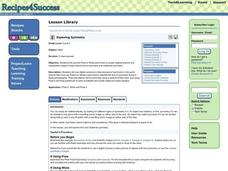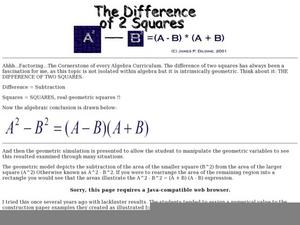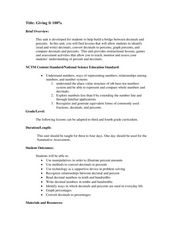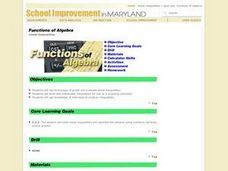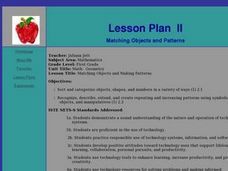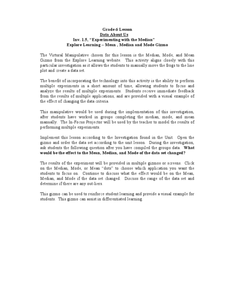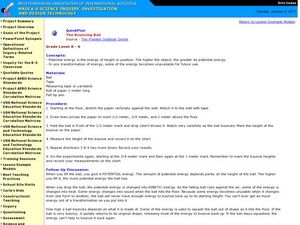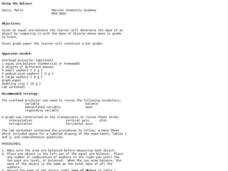Curated OER
Exploring Symmetry
Students use a software program to create artwork and to manipulate images to study mirror and rotational symmetry. They take pictures of items in their environment in which they identify symmetry.
Curated OER
Fractions!
Second graders observe and design manipulatives showing fractional parts. In this fractional part activity, 2nd graders create a paper hamburger using circle fractions. Students navigate a website to find fractional parts of...
Curated OER
The Game of Chance
Third graders use manipulatives to determine the probability of outcomes. In this probability lesson plan, 3rd graders roll dice and use spinners to determine the probability of outcomes. They determine if games are fair/unfair based on...
Curated OER
Volume and Surface Area of Right Rectangular Prisms
Students identify the formulas for three-dimensional figures. They use manipulatives to model problems. Students create foldables and explain volume and surface area. Students complete worksheets and classify solids. Students sing a...
Utah Education Network (UEN)
If the Shape Fits
Geometers juggle the idea of polygons. Using a game and manipulatives, they make trapezoids and irregular polygons. They review the algorithms for finding the areas of squares and rectangles. On day one, they find the area of trapezoids,...
Curated OER
The Difference of 2 Squares
Learners factor a difference of two squares. In this factoring a difference of two squares lesson, students use manipulates cut from a piece of paper to illustrate the difference of two squares. Learners illustrate the...
Curated OER
Investigation So What's The Difference?
First graders investigate the differences between shapes. In this block characteristics activity, 1st graders work in groups to explore blocks, group the blocks by different characteristics, discuss the block attributes and record...
Curated OER
Corresponding Parts of Congruent Triangles
Students identify different parts of a triangle. In this geometry lesson, students differentiate between similar and congruent triangles. They use the navigator to crate a visual of the different parts of a triangle.
Curated OER
Giving it 100%
Learners build knowledge about the number relationships between decimals and percents as it relates to converting decimals into percents. In this decimal and percent instructional activity, students recognize equivalent forms of...
Curated OER
Functions of Algebra
Students use technology graph and evaluate linear inequalities. They write and manipulate inequalities for use on a graphing calculator. In addition they apply their skills to analyze inequalities. Answer Key included.
Curated OER
Matching Objects and Patterns
First graders participate in hands-on activities and use objects to create patterns. They observe a PowerPoint instructional activity describing matching objects and patterns. In groups, 1st graders complete geometry computer activities...
Curated OER
Explore Learning - Mean , Median and Mode Gizmo
Sixth graders experiment with mean, median, and mode. In this online interactive mean, median, and mode lesson, 6th graders analyze the results of multiple experiments and after they work in groups completing the median, mode, and mean...
Curated OER
The Bouncing Ball
Students use the scientific method to conduct an experiment to test how a ball bounces. In this inquiry-based physical science and scientific method activity, students drop a ball from specified heights and record the rebound, then...
Curated OER
Using the Balance
Students determine the mass of various objects. In this integrated math and science lesson plan, students use an arm balance to compare a known object to a combination of washers with a fixed weight. Students record data, construct a bar...
Curated OER
Obtuse Angles
Third graders recognize and identify geometric shapes, work with manipulatives to reinforce understanding, and create polygons with various angles to display their knowledge of the different types of angles.
Curated OER
Piecewise Linear Integral
Young mathematicians solve and graph piecewise functions in this calculus lesson. They integrate linear functions containing restrictions and graph their answers using the TI.
Curated OER
Exploring Vertical Asymptotes
Scholars identify the domain of a rational function in this precalculus lesson. They identify the removable discontinuity and label what will make the denominator zero. Learners also describe properties of the graph as it relates to the...
Curated OER
Midsegments of a Triangle
High schoolers analyze midsegments of triangles in this instructional activity. They use Cabri Jr. software to observe the relationships between interior angles and midsegments of triangles. Specific instructions for creating this...
Curated OER
Developing the Concept Division
Students use manipulatives to explain the concept of dividing multi-digit numbers.
Curated OER
Fractions of a Band
Third graders investigate fractions. In this time lesson, 3rd graders determine the amount of time it takes to perform certain tasks.
Curated OER
Time for a Plumber!
Fourth graders compare amounts of time in seconds, minutes and hours. In this multiplying and comparing time lesson, 4th graders problem solve a plumbing problem scenario to find which amount of time is the least. Students...
Curated OER
Interior Angles of Regular Polygons
Students investigate the interior angles of a triangle. In this geometry lesson, students create the formula to calculate the angles inside a triangle. They observe the total sum of a triangles angle on the navigator.
Curated OER
Exploring Area and Perimeter
Two students are blindfolded and each receives a cardboard square, one with pompoms glued around the edge and one with pompoms glued all over the surface. They identify what they feel. The class discusses perimeter and area of polygons....
Texas Commission on the Arts
The Quarter Fold
Little ones identify the US quarter and explore the concept of one-fourth or one-quarter. Using real coins or coin manipulatives, they divide a square piece of paper into quarters, discuss halves and quarters, and create a design that...
